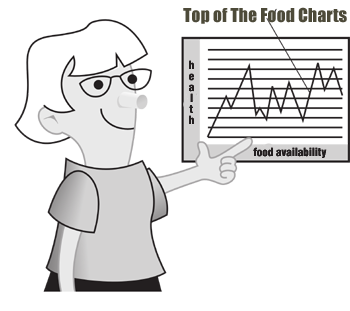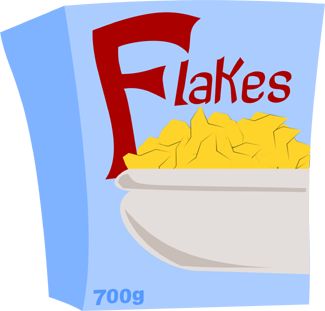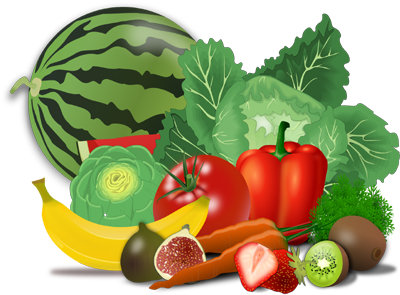Healthy Eating: Why Does The U.S. Fall Behind?
HEALTHY EATING: WHY DOES THE U.S. FALL BEHIND? (ISSUE 114)
By Diane Gold
 We would think that healthy eating in the United States is easy and that we are at the top of the charts when compared to other countries.
We would think that healthy eating in the United States is easy and that we are at the top of the charts when compared to other countries.
So why do we have more dietary sickness (diabetes and obesity) than 120 out of 125 countries (see Oxfam’s Good Enough To Eat chart, mentioned in the New York Times article by Mark Bittman on January 21, whose information is collected from organizations like the World Health Organization).
According to this report which looks at best and worst countries’ food statistics, the United States has the most affordable food, 4th best in quality, 41st best in available water (big surprise), along with the above statistic on health from food and is 21st in having enough food.
I remember having a discussion with one of my virtual assistants in India and his complete shock and disbelief when I said that there are people in the US who are hungry. Obviously, some people have triple what they need, and others do not.
Let’s focus back on the healthy eating topic. Do we eat more healthfully than poorer countries? The answer, tragically, is not as a country. Here’s why.
PESTICIDES AND GMOs
 Farmers use some method of offsetting bugs and weeds on their crop. Many use toxic pesticides which change the basic structure of the fruit or vegetable being grown or add some new chemical structure to the plant by pesticide exposure. This makes the food less healthy.
Farmers use some method of offsetting bugs and weeds on their crop. Many use toxic pesticides which change the basic structure of the fruit or vegetable being grown or add some new chemical structure to the plant by pesticide exposure. This makes the food less healthy.
(See http://warriorsofweight.com/pesticides-which-fruits-veggies-have-least.)
Another series of events may contribute to low health statistics. Farmers are dependent upon seed supply companies of which there are many. If they are convinced through extravagant marketing that genetic modification reduces the need for expensive pesticides, they may opt for seeds that have been genetically changed. (Noteworthy is that the 4 large companies, together, own a whopping 47% of the GMO (genetically modified organism) seed businesses.) There is no study that definitely points to worse health with GMOs, but we do know that some of the resulting modified seeds may be carcinogenic.
The marketing for GMOs is that the GE seeds were structured to enable certain weed killers to be used no harm to the seed and its resulting plant. The GMO seed is also supposed to be stronger so that it requires less pesticide. That’s the hype to get farmers to pay more for seeds because they are GMO.
Unfortunately, in July, 2012, Food and Water Watch came out with a study based on USDA and USEPA statistics that the use of genetically modified seeds does not reduce pesticide use. Also, there may be evidence that GMOs are toxic.
So, why buy GMO seeds, when farmers will not save money on pesticides and when these seed companies require farmers to contract to throw away the seeds after one planting? As humans, we always look to social proof and listen to marketing. If large companies say it’s so, it must be so, right? Never mind the science if we haven’t been exposed to it as often.
So, we consume pesticides galore which cause all sorts of health issues.
SNACKS AND PACKAGED FOODS
 More packaged food than not is in our supermarkets. We use corn and soy, most of it genetically engineered (GE), and sugar, half of it GE, to create fast food with lovely colors. Instead of selling snacks that are fresh food, we buy boxes or bags with ingredients we can’t pronounce. Older generations did it, meaning our parents or grandparents; so why shouldn’t we?
More packaged food than not is in our supermarkets. We use corn and soy, most of it genetically engineered (GE), and sugar, half of it GE, to create fast food with lovely colors. Instead of selling snacks that are fresh food, we buy boxes or bags with ingredients we can’t pronounce. Older generations did it, meaning our parents or grandparents; so why shouldn’t we?
We are more nutritionally educated than in the past, so that’s a good reason not to carry on the habit. The goal of the food industry is for us to buy. Many of us believe that if the food giants with lots of experience produce something, it must be healthy for us to eat.
In the past, we trusted the industry with our nutrition. After all, each company has a research and development team, scientists, doctors and inventors.
Now, we know that the researchers and developers in food are there to cause us to buy the food. Health is of no concern as long as the food passes some very inferior safety testing probably created by the regulators with the help of the industry itself.
Beware that packages that say vegan or organic are still processed food.
GREED
 We are pleasure seekers and taste mongers with our taste buds being bombarded with new combos of flavor. We will do anything for the next delight, whether it be food, body sensation, exercise, drink, color, gadget. What this means with food is that, even though we know that healthy food is crucial, we choose to eat highly fatty, salty, oily foods that taste unbelievably good. And we have developed the habit of eating portions that are much too large, just because we have developed the habit by being served too much in a restaurant or at home.
We are pleasure seekers and taste mongers with our taste buds being bombarded with new combos of flavor. We will do anything for the next delight, whether it be food, body sensation, exercise, drink, color, gadget. What this means with food is that, even though we know that healthy food is crucial, we choose to eat highly fatty, salty, oily foods that taste unbelievably good. And we have developed the habit of eating portions that are much too large, just because we have developed the habit by being served too much in a restaurant or at home.
These habits are waiting to be replaced with healthy eating.
OVERUSE OF ANTIBIOTICS
Our wealth and our propensity for pharmaceutical cures has led us to over-ingest antibiotics. We know there are a good many viruses that cause us to be sick, yet, since the development of penicillin, we have been antibioticking (verb creation going on, here) ourselves unnecessarily.
 Antibiotics do not work against viruses. They also strip the body of the microbiomes needed on an hourly basis in the human digestive tract. A study at Washington University School of Medicine, St. Louis, Mo., published in Pediatrics in 2012, swabbed the nasal passages of young children with unexplained fever and, for control, children without fever. Those with fever had 5 X the viral load of those without. The study’s objective was to to determine whether a quick nasal swab could improve the mistaken prescribing of antibiotics for viral sickness, which always harms microbial balance. The jury is still out, in my opinion, for 2 reasons: the antibiotic industry is massively profitable and there are some very nasty bacteria that can kill the patient if antibiotics are not given in time.
Antibiotics do not work against viruses. They also strip the body of the microbiomes needed on an hourly basis in the human digestive tract. A study at Washington University School of Medicine, St. Louis, Mo., published in Pediatrics in 2012, swabbed the nasal passages of young children with unexplained fever and, for control, children without fever. Those with fever had 5 X the viral load of those without. The study’s objective was to to determine whether a quick nasal swab could improve the mistaken prescribing of antibiotics for viral sickness, which always harms microbial balance. The jury is still out, in my opinion, for 2 reasons: the antibiotic industry is massively profitable and there are some very nasty bacteria that can kill the patient if antibiotics are not given in time.
According to a Mayo Clinic article, antibiotics don’t work on bronchitis, colds, flu, most coughs, most ear infections, most sore throats, stomach flu. According the CDC’s Antibiotic Resistance Threats In The United States 2013,
“… up to 50% of all the antibiotics prescribed for people are not needed or are not optimally effective as prescribed.”
2 articles in the Journal Of The American Medical Association headed by Gonzalez, R. in 1997 and Nyquist, AC in 1998 came up with the statistic that colds that 23 million prescription annually were written for bronchitis, colds and upper-respiratory infection.
At that time, it was 1 in 5 antibiotic prescriptions being wrongly prescribed.
The use of antibiotics causes needed healthy bacteria to disappear, which enables antibiotic resistance and causes immune system vulnerability taking away some of our good health.
LACK OF NUTRITION EDUCATION
 How long is the nutrition course in our schools? What? There isn’t one, or there was that one day when Chelsie’s mom, the chef, came in? We learn how to read, how to write, how to add and subtract numbers so that we can go to the bank and shop, but is there an ongoing course to teach us how to sustain our health through food or teach us what to buy based on budget?
How long is the nutrition course in our schools? What? There isn’t one, or there was that one day when Chelsie’s mom, the chef, came in? We learn how to read, how to write, how to add and subtract numbers so that we can go to the bank and shop, but is there an ongoing course to teach us how to sustain our health through food or teach us what to buy based on budget?
Although much has changed since I went to school, nutrition is currently a sporadic course in most schools. A great schedule would be to offer it twice a week from pre-school through high school, along with and not instead of physical education. Why did it take America’s failing health to remind us to include this hugely important subject?
MONEY, MONEY, MONEY, MONEY
We make many choices about what we eat based upon how much we have to spend. Of course, this is a huge factor that requires further discussion. It is so important that it is best discussed in school as well as in the home.
WHAT CAN YOU DO AKA WHAT ACTION STEPS CAN YOU TAKE?
 1) You can suggest to the editor of your local newspaper to have a natural foods home from school snack contest, vegan and non-vegan, organic and non-organic, on which the entire community’s children can vote. It will stimulate creativity, allow others to share recipes, build awareness and promote health in snacking. Plus, it will educate our kids to the possibilities available with whole foods.
1) You can suggest to the editor of your local newspaper to have a natural foods home from school snack contest, vegan and non-vegan, organic and non-organic, on which the entire community’s children can vote. It will stimulate creativity, allow others to share recipes, build awareness and promote health in snacking. Plus, it will educate our kids to the possibilities available with whole foods.
You can ask your local health food store and supermarket to donate ingredients.
2) When you go to see your doctor or health professional, have a fully transparent discussion about the nature of any treatment prescribed for you. This includes asking which research the professional thinks will help you get the facts and understand the risks. Although the expression,
“You are under my care,”
is very common, we must take responsibility for staying aware and making choices with our health advisor.
Doctors like talking to informed patients and, if you are respectful of the provider’s expertise, many will have very informative discussions with you and will share more with you the more you know.
3) Go to your local elementary school and ask what the sequence of nutrition education is for each grade in the school. Do the same at the middle and high schools. Yes, even if you do not have a child in school or in that grade.
If there’s no set curriculum, suggest starting one. Here are some references:
vrg.org/nutshell/nutshell.htm#teaching
cde.ca.gov/search/searchresults.asp?cx=001779225245372747843:gpfwm5rhxiw&output=xml_no_dtd&filter=1&num=20&start=0&q=nutrition%20educationfrom
fnic.nal.usda.gov/professional-and-career-resources/nutrition-education/curricula-and-lesson-plans
Keep in mind that if food industry manufacturer has helped to create a curriculum, the lesson plan will be biased in the direction of the food manufacturer’s philosophy (such as, the meat and dairy industry would not advocate a vegan diet). Also, many curricula leave out the vegan diet. Put it in as a remarkably healthy option.
CONCLUSION
Healthy eating is on us as individuals. It’s on us to lead the education system to teach nutrition and plant-based nutrition in the classroom.
In general, we need to choose curricula that are not connected with any particular industry or company, since most offer free curricula to promote their cause.
We have the strongest country in the world. Let’s understand our nutritional downfalls, and let’s get around to healthy eating.
![]()
FOOD FOR THOUGHT

How can we manufacture food? Food grows.
![]()
![]()
FEEDBACK
We value your feedback very much.
Please leave a comment.
Please LIKE us on the website and at WarriorsOfWeight on Facebook. Thanks.
![]()
DIANE GOLD, AUTHOR
Diane Gold, Founder of Warriors of Weight, Turning Habits Into Health, is a mentor in tai chi, kung fu and meditation, a music, fitness and stress expert, dedicated mom, studying plant-based nutrition and habit change.
She sees lots of bad education and believable marketing about food (and drugs) that have no place in realism. Because people are naive and don’t demand more, they get duped. She says,
“We are right to be trusting and loving. This is number one. However, we are also right to discern love and concern from profit motive and corporate advancement. Just as familes love each other more than anything, corporations love more sales than anything. It is crucial for us to know the sources of all the ingredients we ingest, which we don’t, which means we can’t make informed decisions about whether we want to eat the food. But we eat it anyway. (Same with pharmaceuticals.)
“It is fair to think that the regulations on food (and drugs) have been influenced by the food (and pharmaceutical) industries. It is the industry’s job to make as many sales as possible, even if it persuading us with nebulous or false or omitted information. It is fair that we have to do our own research on healthy eating. It is also fair for us to speak out to change safety standards and require labels to include sourcing of each ingredient, waxing of every piece of produce and source of each fertilizer that goes into the ground that grows our produce.
“We are a long way off from transparency in any of these areas. So, let’s look at the research on regulations and regulators. And let’s be diligent when we believe what we hear. These kinds of actions will help us in the United States and abroad with raising the bar on healthy eating.”
![]()







